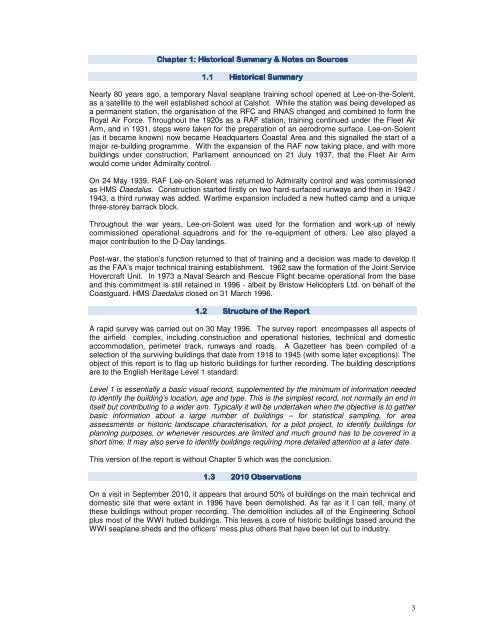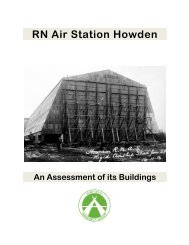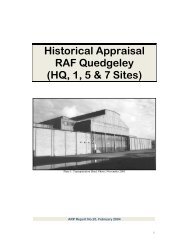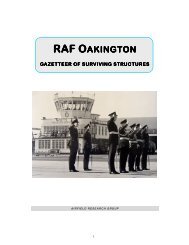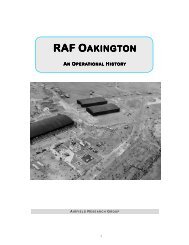RNAS Lee - The Airfield Research Group
RNAS Lee - The Airfield Research Group
RNAS Lee - The Airfield Research Group
Create successful ePaper yourself
Turn your PDF publications into a flip-book with our unique Google optimized e-Paper software.
Chapter Chapter 1: 1: Historical Historical Summary Summary & & Not Notes Not es on on Sources<br />
Sources<br />
1.1 1.1 Historical Historical Summary<br />
Summary<br />
Nearly 80 years ago, a temporary Naval seaplane training school opened at <strong>Lee</strong>-on-the-Solent,<br />
as a satellite to the well established school at Calshot. While the station was being developed as<br />
a permanent station, the organisation of the RFC and <strong>RNAS</strong> changed and combined to form the<br />
Royal Air Force. Throughout the 1920s as a RAF station, training continued under the Fleet Air<br />
Arm, and in 1931, steps were taken for the preparation of an aerodrome surface. <strong>Lee</strong>-on-Solent<br />
(as it became known) now became Headquarters Coastal Area and this signalled the start of a<br />
major re-building programme. With the expansion of the RAF now taking place, and with more<br />
buildings under construction, Parliament announced on 21 July 1937, that the Fleet Air Arm<br />
would come under Admiralty control.<br />
On 24 May 1939, RAF <strong>Lee</strong>-on-Solent was returned to Admiralty control and was commissioned<br />
as HMS Daedalus. Construction started firstly on two hard-surfaced runways and then in 1942 /<br />
1943, a third runway was added. Wartime expansion included a new hutted camp and a unique<br />
three-storey barrack block.<br />
Throughout the war years, <strong>Lee</strong>-on-Solent was used for the formation and work-up of newly<br />
commissioned operational squadrons and for the re-equipment of others. <strong>Lee</strong> also played a<br />
major contribution to the D-Day landings.<br />
Post-war, the station’s function returned to that of training and a decision was made to develop it<br />
as the FAA’s major technical training establishment. 1962 saw the formation of the Joint Service<br />
Hovercraft Unit. In 1973 a Naval Search and Rescue Flight became operational from the base<br />
and this commitment is still retained in 1996 - albeit by Bristow Helicopters Ltd. on behalf of the<br />
Coastguard. HMS Daedalus closed on 31 March 1996.<br />
1.2 .2 Structure of the Report<br />
A rapid survey was carried out on 30 May 1996. <strong>The</strong> survey report encompasses all aspects of<br />
the airfield complex, including construction and operational histories, technical and domestic<br />
accommodation, perimeter track, runways and roads. A Gazetteer has been compiled of a<br />
selection of the surviving buildings that date from 1918 to 1945 (with some later exceptions). <strong>The</strong><br />
object of this report is to flag up historic buildings for further recording. <strong>The</strong> building descriptions<br />
are to the English Heritage Level 1 standard:<br />
Level 1 is essentially a basic visual record, supplemented by the minimum of information needed<br />
to identify the building’s location, age and type. This is the simplest record, not normally an end in<br />
itself but contributing to a wider aim. Typically it will be undertaken when the objective is to gather<br />
basic information about a large number of buildings – for statistical sampling, for area<br />
assessments or historic landscape characterisation, for a pilot project, to identify buildings for<br />
planning purposes, or whenever resources are limited and much ground has to be covered in a<br />
short time. It may also serve to identify buildings requiring more detailed attention at a later date.<br />
This version of the report is without Chapter 5 which was the conclusion.<br />
1.3 2010 2010 Observations<br />
Observations<br />
On a visit in September 2010, it appears that around 50% of buildings on the main technical and<br />
domestic site that were extant in 1996 have been demolished. As far as it I can tell, many of<br />
these buildings without proper recording. <strong>The</strong> demolition includes all of the Engineering School<br />
plus most of the WWI hutted buildings. This leaves a core of historic buildings based around the<br />
WWI seaplane sheds and the officers’ mess plus others that have been let out to industry.<br />
3


